Name Madge Tennent | Role Artist | |
 | ||
Full Name Madeline Grace Cook Known for Painting, drawing, sculpture Education | ||
Pioneering art of madge tennent on display sept 16 2016
Madge Tennent (22 June 1889 – 5 February 1972) was a naturalized American artist, born in England, raised in South Africa, and trained in France. She ranks among the most accomplished and globally renowned artists ever to have lived and worked in Hawaiʻi.
Contents
- Pioneering art of madge tennent on display sept 16 2016
- December Issue 16 Bodega Bay Heritage Gallery Monthly
- Early life
- Paris 1902 1906
- Return to Cape Town and Marriage 1907 1915
- New Zealand and British Samoa 1915 1923
- Honolulu 1923 1972
- Artistic Evolution Style
- Creed
- International Recognition
- Legacy
- References

A child prodigy, Tennent spent her formative teenage years in Paris, where she honed technical mastery under the tutelage of William-Adolphe Bouguereau; simultaneous exposure to the city's leading avant-garde artists, including Paul Cézanne, Pierre-Auguste Renoir, and Pablo Picasso, stoked her pioneering vision. Having served as an art educator in South Africa, New Zealand, and British Samoa, she settled in Honolulu with her husband and children in 1923.
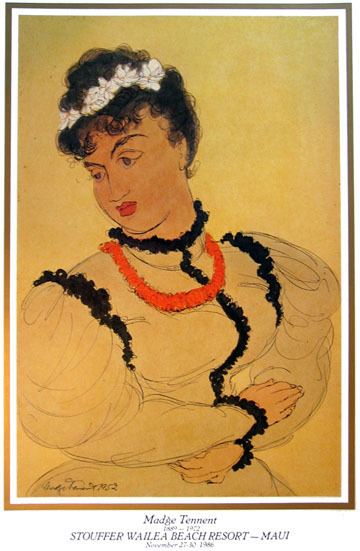
Tennent's prolific output spanned paintings, drawings, and sculpture. Her reverent fascination with Hawaiian women inspired the sweeping aesthetic quest that would culminate in an iconic signature style: enormous paintings of voluptuous female figures that synthesized brilliant, swirling hues into graceful, harmonious compositions. A prominent figure on the international circuit, Tennent exhibited to critical and popular acclaim around the world. At the time of her death, many critics considered her the most important individual contributor to Hawaiian art in the 20th century.

December Issue '16 Bodega Bay Heritage Gallery Monthly
Early life
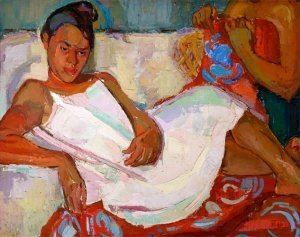
She was born Madeline Grace Cook in Dulwich, England, the first of two daughters born to Arthur and Agnes Cook. Her father was an architect, seascape painter, and fine craftsman in woodcarving, while her mother owned, edited, and wrote for a weekly magazine titled South African Women in Council. Having settled in Cape Town by 1894, the Cooks took a lively interest in comparative creeds that embraced many religions, as well as in matters of psychic and astrological trend. Madge and her sister Violet were nurtured in this stimulating, creative environment, learning to read and write at an early age. Agnes was an accomplished pianist who taught Madge, in particular, to play. Her parents’ efforts to promote tolerance among various races and creeds left a lasting impression on her.
Paris (1902-1906)
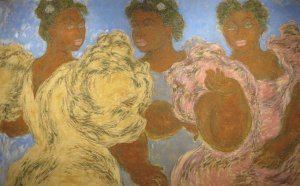
Although Madge attended an English boarding school and, later, a French Convent school in Paris, she otherwise had little formal schooling. Her talent for drawing prompted her parents to enroll her at age twelve in the Cape Town School of Art, where classes were limited to drawing from casts, still life, and portraiture; within a year, she had mastered and surpassed the curriculum. Her parents thus decided to relocate the family to Paris, where Madge could pursue more advanced training in the disciplines of art.
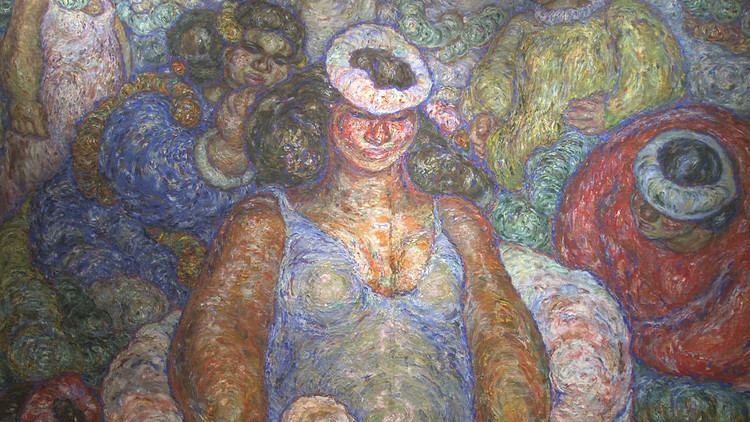
At the Académie Julian, Madge was quickly identified as a child prodigy and invited to study under William-Adolphe Bouguereau, a prominent artist-educator closely identified with Academic art. In competition with older students from five academies, a 13-year-old Madge placed fifth with her full length charcoal drawing of a nude model. Her drive to draw and paint well was sustained without pause as she worked long hours each day. With her family she often visited the Louvre, where she could check her own progress in the realm of the masters.
Return to Cape Town and Marriage (1907-1915)
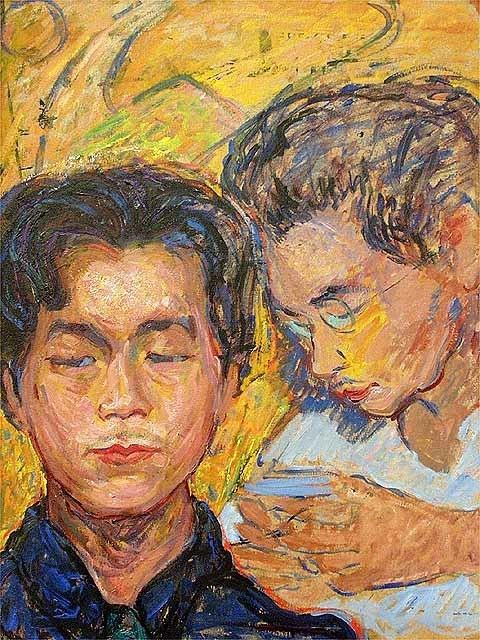
The Cooks were steeped in the cultural life of Paris, but due to financial reverses, they returned to Cape Town in 1907. Madge was soon appointed the headmistress in art for several girls' schools in different cities of South Africa and the director of a government art school in Cape Town. At age 18, she began exhibiting her work widely. In response to one such exhibition, a critic observed, "One must be a mystic to recognize the meaning with which the pictures are invested."

By 1913, Madge had established her own art school and resumed her piano recitals. Attending one was Hugh Cowper Tennent, a chartered accountant from New Zealand who was stationed in Cape Town with the Natal Light Horse regiment. One of 11 children born to Robert and Emily Tennent, Hugh courted the 26-year-old Madge for three months following their introduction on 25 July 1915. The two were married and, shortly thereafter, embarked to New Zealand.
New Zealand and British Samoa (1915-1923)
Again Madge directed an art school, having been appointed head instructor at the Government School of Art in Woodville, the village where Madge and Hugh lived while he awaited further military orders. On 11 June 1916, she gave birth to Arthur Hugh Cowper Tennent, the first of two sons. When orders came, Hugh was posted to France in support of the allied effort in World War I. Madge relocated to her parents-in-law's home in Invercargill for the duration of Hugh's service abroad.
Hugh returned from France in 1917 with a badly wounded arm. An accountant by trade, he was offered a position as treasurer to the government of British Samoa, which he chose to accept. The Tennents lived in Samoa for six years, during which time Madge was able to indulge a fascination with the native people of Polynesian descent. Madge was able to devote much of her time to drawing charcoal portraits of Samoans.
Honolulu (1923-1972)
In 1923, en route to England to enroll their sons in school, the Tennents stopped over in Honolulu. It was to have been a brief stop, but they soon were persuaded by members of the local cultural elite, including poet Don Blanding, to stay on. Madge was immediately taken with the Hawaiian people.
Artistic Evolution & Style
While her husband worked to build his accountancy firm, Madge Tennent supported her family as a portrait artist. With remarkable success, she drew countless child and adult portraits, mainly of Caucasian families. There was little challenge in this, however, and her imagination was already ablaze with the beauty she recognized in the Native Hawaiian and variously multiracial peoples she longed to portray. A book of Gauguin reproductions sparked her impetus to expand upon her study, research, drawing, and painting. With a strong insight into the Polynesian aesthetic, she envisioned Hawaiian kings and queens as "having descended from gods of heroic proportion, intelligent and brave, bearing a strong affinity to the Greeks in their legends and persons." It was this reverent vision of the Hawaiians that she would endeavor to convey to the world.
Influences of seminal European antecedents conspicuously permeated Tennent's transitional paintings of the late 1920s and early 1930s, such as Bathers (1926), Hawaiian Girl (1926), Girl with Apples (1926), Makuahine (1927), and Olympia of Hawaii (with Apologies to Manet) (1927). Olympia of Hawaii, in the collection of the Honolulu Museum of Art, exemplifies Tennent's enchantment with color and use of the bright, warm hues endemic to Hawaiʻi. She adapted line and form to the appropriately vivid medium of oil. The majestic, explicitly Polynesian women that would figure in Madge Tennent’s iconic imagery surfaced in works such as Reclining Girl (1929) and Three Filipino Ladies (1930), each a synthesis of European modernism’s languid, architectonic femininity with Tennent's own racial fixation. Generously applying paint with a palette knife, she avoided sensuousness in the representation of skin texture, instead imbuing the trademark sense of strength and grandeur tinged with fragility apparent in Holoku Ball and Hawaiian Singer (early 1930s). Just as Tennent constructed her wahines layer by layer in paint, she built her canvases to equally monumental proportions; when standard issue could no longer satisfy her vision, she sewed pieces of canvas together to attain the desired size.
By the mid-1930s, Tennent’s works had evolved into the mammoth oils of majestic Hawaiian women that remain her signature to this day. She tapped a brilliant, decidedly tropical color palette to create Hawaiians Hanging Holoku, Lei Queen Fantasia, and Local Color (all 1934), depicting native women engaged in lei-making, dancing, and similarly island-specific activities. Hawaiian Bride (1935), one of the few paintings with which Tennent was "almost satisfied," marked a turning point in the development of her distinctive style; there, as in the concurrent Girl in Red Dress (1935) and Two Lei Sellers (1936), she achieved an ethereal intensity with softer hues and blurred, iridescent forms. In these later works, whirling wisps of complementary oils fuse the figures to their floral surroundings, visualizing the resilient bonds Tennent perceived between the body and spirit of Hawaii. In the summer of 1935, all six canvases traveled from Honolulu to Europe for a series of major one-woman exhibitions that established Tennent's presence on the global art circuit.
Her refusal to feel entirely satisfied with her output, even in the face of widespread acclaim, reflected her conviction that the artist “evolves through conscious effort.” This conscious evolution became strikingly apparent in the early 1940s, whereupon Tennent’s famously vibrant, swirling colors and thick, granular strokes gave way to a subdued monochrome, as in Three Musicians Subdued in Harmony (1940). Thereafter followed paintings in shades of ocean blues and earthy island sepias on linen, such as Hawaiian Three Graces (1941), Three Hawaiian Women (1941), and Three Hawaiians in a Library (1943). Three Hawaiian Women, in the collection of the Honolulu Museum of Art, demonstrates this stark contrast to the polychromatic blaze of her earlier works and evidences her lasting belief that “every true artist knows that his work must evolve or die […] therefore, the moment he has perfected some type of style of expression peculiar to himself he must move on or he becomes academic.” Working on a smaller scale in the 1950s, for example, Tennent executed a series of portraits featuring Hawaiian alii in oils, prints, and watercolors; she treated Hawaiian royalty as descendants from the gods, possessed of heroic proportions and serene facial features that conveyed “a gentleness that tends to make a predominance of convex lines, only seen in the great art of the world.” Until her death in 1972, Tennent would continuously diversify across media and scale, but never once did she stray from or grow tired of her beloved Hawaiian subjects.
Creed
International Recognition
A renowned art educator as well as painter of modern figurative canvases of Hawaiian subjects, Madge Tennent had a distinguished career based primarily in Hawaii from where she sent paintings to the mainland United States for exhibitions in New York City and Chicago between 1930 and 1939. She was among the first artists to embrace native Hawaiians as a primary subject matter, whom she depicted as large and robust with audacious, swirling forms and colors. Two Sisters of Old Hawaiʻi in the collection of the Hawaii State Art Museum is an example of her large paintings of Hawaiian women. Her influence was increased by her association with the Honolulu Museum of Art in its early days, where she was a frequent lecturer, and where she was included in most of the Academy’s early group shows.
Mainland and international exhibitions include:
Legacy
After a decade of gradually declining health, Madge Tennent died in Honolulu on 5 February 1972. Three days later, the Hawaiʻi State Senate commemorated the artist's vision, accomplishments, and influence:
WHEREAS, Madge Tennent, one of Hawaii's most important artists, died on February 5, 1972 in the 82nd year of her long and eventful life; and
WHEREAS, better than any artist to date, Madge Tennent was able to capture and honestly express in her many paintings and drawings the subtle charm and quiet grace and dignity of the Hawaiian people; and
WHEREAS, Madge Tennent was also a warm and generous person, who gave often and generously of her works to friends and to charity; and
WHEREAS, Madge Tennent, having spent a half century in Hawaii, leaves behind a rich legacy of art, which shall forever belong to Hawaii; and therefore,
"Even if the Hawaiians were to vanish as a race, they would live forever in the paintings of Madge Tennent," remarked noted Native Hawaiian scholar and author John Dominis Holt. "No other artist in Hawaii has so consistently and eloquently painted, sketched, and drawn the Hawaiian Woman as has Tennent. In the physical form of a larger Hawaiian woman, she established the basis upon which to build a lasting, universal aesthetic statement. She gave her life effort and her great talent to the elaboration of this vision." In 2005, Tennent was named one of the 100 most influential contributors to the city of Honolulu. Her large-scale oils on canvas and board have reportedly sold for over $1 million.
The Fine Arts Museums of San Francisco, the Hawaii State Art Museum, the Honolulu Museum of Art, the National Museum of Women in the Arts (Washington, D. C.), and the Victoria and Albert Museum (London) are among the public collections holding works by Madge Tennent. The single largest intact collection of her works resides at the Isaacs Art Center, which in 2005 was named caretaker of the Tennent Art Foundation.
